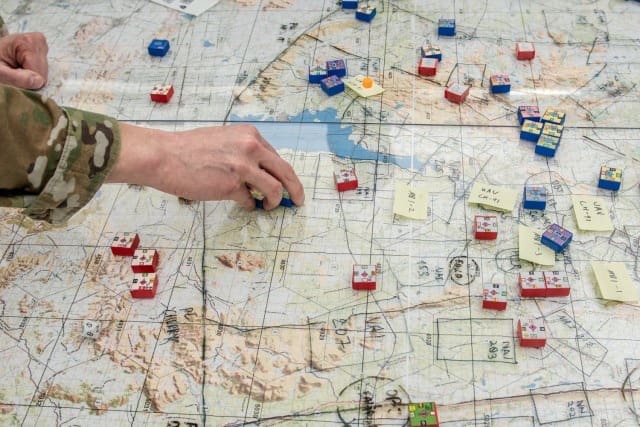US Army Rangers Showcase Advanced Tactical Skills in CAPEX Exercise
FORT BRAGG, North Carolina In a striking display of modern military capabilities, US Army Rangers showcased their skills during an airborne assault demonstration, utilizing fast rope techniques from an MH-47 Chinook helicopter. This dynamic exercise formed part of the annual Capabilities Exercise, commonly referred to as CAPEX, conducted by the US Army Special Operations Command (USASOC) last week. The event, which was open to the public, provided a unique glimpse into the training regimen and operational readiness of US Army Special Operations Forces (ARSOF) in the face of contemporary threats.
The exercise commenced with an ominous and captivating scene as a swarm of quadcopter drones filled the sky, their buzzing noise reminiscent of a swarm of angry bees. The drones, small and agile, zipped over barren dirt roads and abandoned buildings, quickly escalating in number and intensity. Suddenly, the air was filled with the sounds of explosions, as simulated bombs fell from the drones, creating chaos on the ground. Participants acted out the aftermath with wounded actors collapsing, screaming, and covered in fake blood, immersing onlookers in the intensity of the training scenario.
This year, the CAPEX scenario was particularly timely and relevant, focusing on a hypothetical Chinese invasion of Taiwan, a subject of growing international concern as China continues to modernize its military capabilities. Leading the briefing, Lt. Gen. Jonathan Braga, the commanding general of USASOC, warned of the increasing threat posed by China, particularly emphasizing the year 2027 as a critical target date set by Chinese Communist Party leader Xi Jinping for military readiness. While a direct invasion remains uncertain, Braga labeled this potential conflict as by exponential means, the greatest threat we have, underscoring its implications for US military strategy.
The training exercise also highlighted the significant transition American special operators are currently undergoing. For decades, the focus has been predominantly on counterterrorism and counterinsurgency operations. However, military leaders have acknowledged the need to shift toward great-power competition and prepare for potential conflicts with major adversaries, necessitating the acquisition of new skill sets. This evolution reflects a broader return to Cold War-era strategies and tactics, adapting to a rapidly changing global landscape.
Throughout the CAPEX, ARSOF personnel elaborated on their priorities, which prominently feature the integration of drones and uncrewed systems. The initial simulated drone attack staged by enemy forces served as a catalyst for ARSOF to exhibit their crisis management and medical response capabilities. Despite the chaos, the response was characterized by a remarkable level of organization, with personnel tending to both superficial injuries and more serious wounds, demonstrating their readiness to handle real-world crises effectively.
The action intensified when ARSOF launched an offensive raid into enemy territory, aiming to establish a temporary air corridor for follow-on forces. From a vantage point, observers witnessed a coordinated assault team erupt from their cover, unleashing a barrage of rapid-fire M240B machine gun rounds, generating a deafening cacophony of sound. The team swiftly secured control of an area surrounding a Russian-made SCUD tactical ballistic missile, showcasing their ability to neutralize critical threats.
As enemy uncrewed aerial systems began to swarm the area, ARSOF employed counter-drone strategies, utilizing advanced capabilities to detect, track, and ultimately neutralize the incoming threats. Officials highlighted the use of sophisticated counter-UAS systems that incorporate sensors and interceptor drones to execute a command-link takeover, effectively severing the connection between enemy drones and their operators. This strategic countermeasure enabled the assault team to identify the launch point of hostile drones, allowing them to employ loitering munitions and additional drones to eliminate targets with precision.
With the air corridor secured, additional forces from the 75th Ranger Regiment and the 160th Special Operations Aviation Regiment rapidly entered the operational area, setting their sights on a vital enemy command and control center. Two MH-47 Chinook helicopters, specially designed for special operations, made a swift entrance, creating a whirlwind of dust and debris as they approached. In a stunning display of agility, assault squads fast-roped from the helicopters onto the rooftops of adjacent structures, demonstrating a critical insertion technique.
Once on the ground, the teams swiftly cleared the buildings before preparing to execute an explosive breach of the enemy command center. First-person-view drones flew overhead, providing invaluable situational awareness during the operation. As the teams breached the entrance, they engaged in close-quarters combat, swiftly neutralizing enemy combatants.
The exercise was not without its challenges, as enemy forces mounted a counterattack. ARSOF units responded with an array of weaponry, including Carl Gustaf Recoilless Rifles, M240B machine guns, M320 grenade launchers, 60mm mortar systems, and Javelin missiles. The counterattack was efficiently thwarted, showcasing the effectiveness of ARSOF tactics.
Wrapping up the demonstration, ARSOF also deployed a High Mobility Artillery Rocket System (HIMARS) to target enemy air defenses, maintaining the integrity of the air corridor for further operations. The CAPEX exercise not only provided a whirlwind overview of potential battle scenarios in the event of a Chinese invasion but also showcased the multifaceted nature of ARSOF. Their capabilities extend beyond combat, highlighting the importance of Civil Affairs, language training, and the emphasis on physical and mental resilience.
Col. Luke VanAntwerp, the director of US Army Special Operations Command's Capability Development Integration Directorate, remarked on the efficiency of ARSOF, calling them "an incredible bargain" for the US military. He emphasized the critical role that a small number of highly skilled operators play in deterring conflict and, if necessary, exacting a significant toll on adversaries. Currently, USASOC comprises around 33,000 personnel, representing less than 6% of the Army but accounting for over 51% of the US militarys special operations forces. These operators are deployed in more than 70 countries, proficient in 17 different languages, and are committed to fostering partnerships, preventing conflict, and maintaining situational awareness in an increasingly complex global environment.











